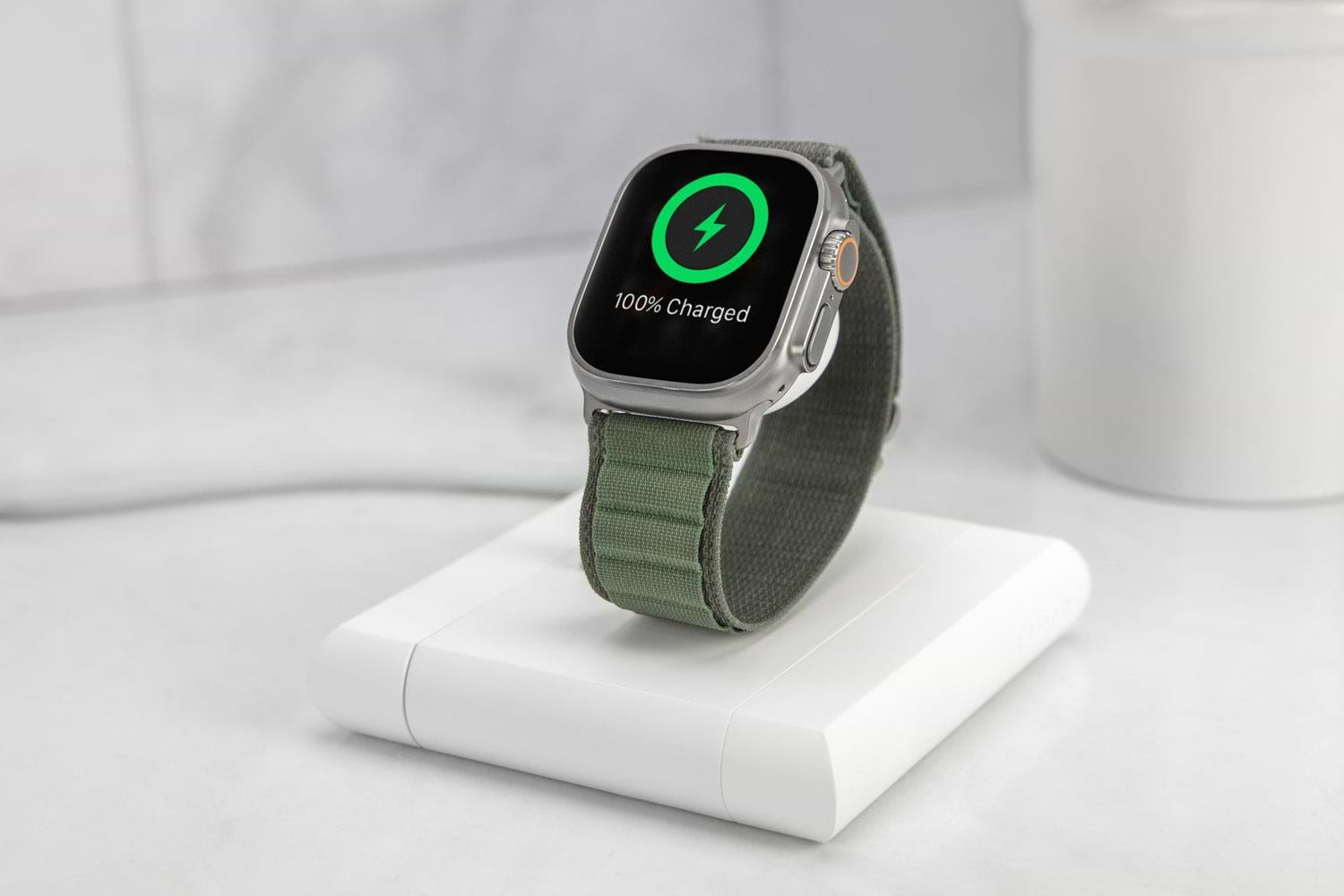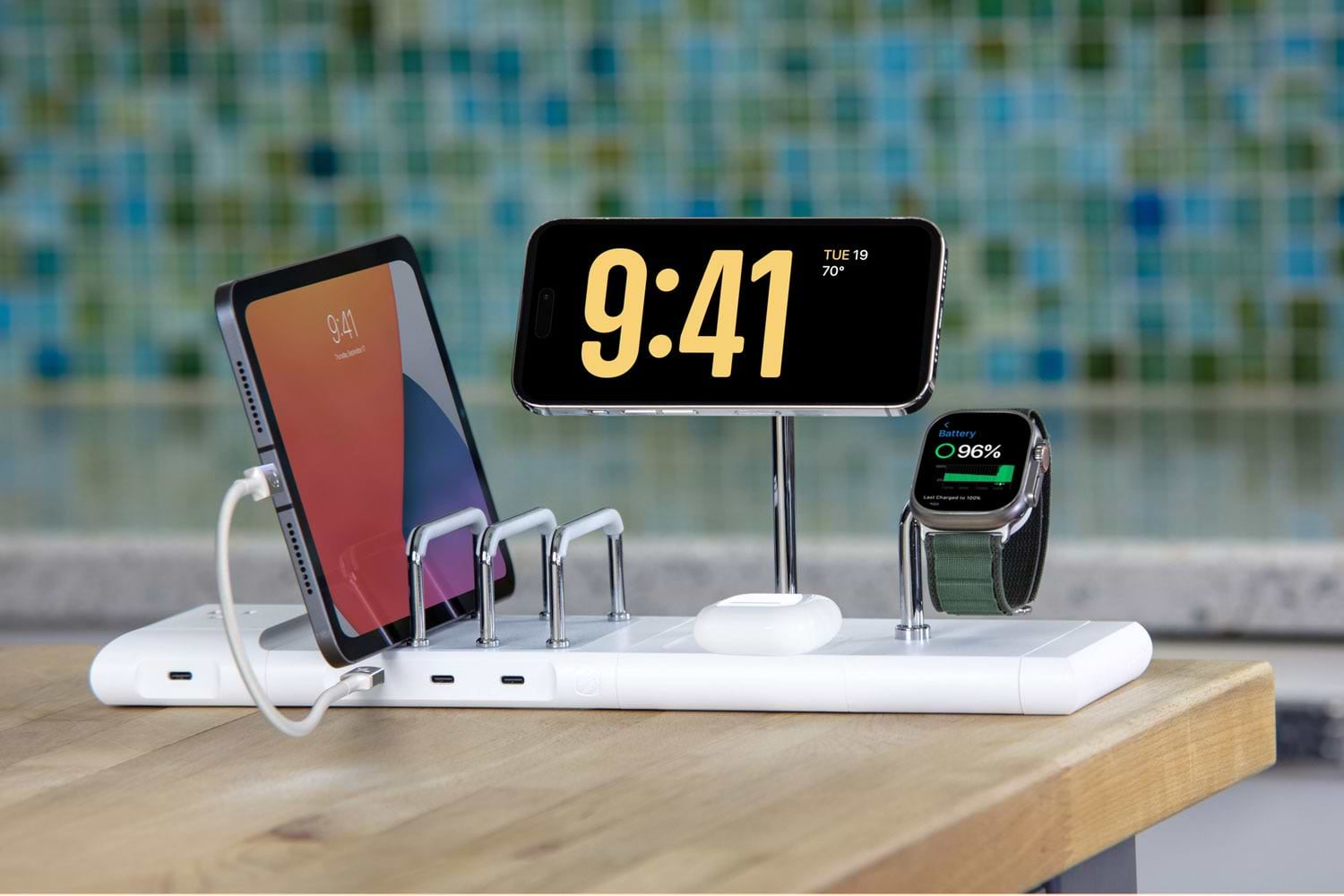Best Practices for Apple Watch Charging

In today's technology-driven world, staying connected is more important than ever. And with devices like the Apple Watch becoming an integral part of our daily lives, it's essential to ensure that they are always ready to go when we need them. One key aspect of Apple Watch maintenance is proper charging.
In this article, we will explore some best practices for Apple Watch charging to help you optimize your device's battery life and keep it running smoothly.
Understanding Your Apple Watch Battery
The first step in optimizing your Apple Watch charging routine is understanding the basics of your device's battery life. The Apple Watch is equipped with a lithium-ion battery, which is known for its efficiency and reliability. However, like all batteries, the capacity of the Apple Watch battery will naturally degrade over time with regular use.
It's fascinating to note that lithium-ion batteries, like the one in your Apple Watch, are designed to have a lifespan of around 2-3 years before their capacity starts to diminish. Factors such as temperature, charging habits, and usage patterns can all impact the longevity of your battery.
The Basics of Apple Watch Battery Life
To make the most of your Apple Watch battery life, it's crucial to be mindful of a few key factors. First, it's important to note that the battery life of your Apple Watch will vary depending on usage and settings. Activities like using third-party apps, receiving notifications, or making phone calls will consume more power compared to simply checking the time.
Moreover, did you know that enabling features like Background App Refresh and Raise to Wake can also have an impact on your battery life? By customizing your settings and disabling unnecessary features, you can extend the time between charges and enhance the overall performance of your Apple Watch.
Additionally, screen brightness plays a significant role in battery consumption. Keeping your screen brightness at a reasonable level rather than cranking it up to the maximum can go a long way in preserving your battery life.
How to Check Your Apple Watch Battery Health
To check the health of your Apple Watch battery, you can access the Battery section in the Apple Watch app on your iPhone. Here, you will find valuable information about your battery capacity, charging patterns, and any potential issues that may be affecting its performance.
Monitoring your battery health regularly can provide insights into your charging habits and help you identify any unusual behavior that may require attention. By staying informed about your Apple Watch battery's health, you can proactively address any issues and ensure that your device continues to deliver optimal performance throughout its lifespan.
Essential Tips for Charging Your Apple Watch
Now that you have a better understanding of your Apple Watch battery, let's dive into some essential tips for charging your device.
Ensuring your Apple Watch stays charged and ready to go is crucial for seamless usage throughout your day. By following some best practices for charging, you can optimize the battery life of your device and minimize any downtime due to low battery levels.
Optimal Charging Time for Apple Watch
When it comes to charging your Apple Watch, it's essential to find the optimal charging time to ensure your device is ready when you need it. Most Apple Watch models can reach 80 percent battery capacity within 1.5 hours of charging, while a full charge can take up to 2.5 hours.
To take full advantage of your Apple Watch's battery capacity, consider charging it when you're not actively using it, such as overnight or during a period of low activity. This way, you can start your day with a fully charged device.
Moreover, it's worth noting that frequent top-up charges throughout the day can also help maintain your Apple Watch's battery level and reduce the need for longer charging sessions. By incorporating short charging bursts into your routine, you can keep your device powered up without interrupting your daily activities.
Using the Right Apple Watch Charger
Using the right charger for your Apple Watch is crucial for efficient and safe charging. Apple Watch chargers are designed specifically for this device and offer the best compatibility and performance. It's always recommended to use the original charging cable and power adapter provided by Apple.
In some cases, you may find it necessary to replace your charging cable or power adapter due to wear and tear. When selecting a replacement, opt for official Apple accessories or reputable third-party options that are MFi (Made for iPhone) certified to ensure they meet the necessary safety and quality standards.
Remember, the charging efficiency of your Apple Watch can also be influenced by the power source you connect it to. Using a high-quality USB port or wall adapter can help maintain a stable power flow to your device, resulting in faster and more reliable charging sessions.


Prolonging Your Apple Watch Battery Life
In addition to following the best practices for charging your Apple Watch, there are several steps you can take to maximize the overall battery life of your device.
But first, let's dive into the world of battery optimization and explore some lesser-known tips and tricks that can help you squeeze every last drop of power out of your Apple Watch.
Adjusting Your Apple Watch Settings for Better Battery Life
One of the most effective ways to prolong your Apple Watch battery life is by optimizing its settings. Here are some key settings you can adjust:
- Disable unnecessary notifications: Limiting the number of notifications you receive can help conserve battery power. Do you need to know every time your favorite social media influencer posts a new selfie?
- Turn off raise-to-wake: Disabling the raise-to-wake feature will prevent the screen from turning on every time you lift your wrist. Sure, it's convenient, but do you need your watch to wake up every time you accidentally brush against your desk?
- Reduce screen brightness: Lowering the screen brightness can significantly extend your battery life. Plus, it can also save your eyes from the blinding glare of a supernova-like display.
- Enable power-saving mode: Activating the power-saving mode will disable certain features and limit functionality to conserve battery power. It's like putting your Apple Watch on a strict energy-saving diet.
The Role of Apps in Battery Consumption
When it comes to battery consumption, apps play a significant role. Some apps may be more power-hungry than others, draining your battery faster. To manage app usage and improve battery life, consider the following:
- Close unused apps: Make it a habit to close apps that you no longer need, especially those running in the background. Think of it as tidying up your virtual workspace, except instead of organizing files, you're saving precious battery life.
- Disable unnecessary app features: Some apps have features that continuously run in the background, using up valuable battery life. Disable or limit these features whenever possible. Do you need your fitness app to constantly track your every move, even when you're just binge-watching your favorite TV show?
By implementing these strategies, you can become the master of battery optimization for your Apple Watch. So go ahead, take control of your device's power consumption, and enjoy an extended battery life that will keep you going throughout the day.
Troubleshooting Common Apple Watch Charging Issues
Despite our best efforts, there may be times when you encounter issues while charging your Apple Watch. Here are two common problems and how to address them:
Dealing With Slow Charging
If you find that your Apple Watch is charging slower than usual, there are a few steps you can take:
- Check the charger and cable: Ensure that both the charger and cable are clean and free from debris. If you notice any damage, consider replacing them.
- Remove any case or cover: Some cases or covers may interfere with the charging process. Try removing them and see if it makes a difference.
- Restart your Apple Watch: Restarting your Apple Watch can sometimes resolve minor software issues that may be affecting the charging process.
It's also worth noting that using a higher-wattage charger, such as the one that comes with an iPad, can potentially speed up the charging process for your Apple Watch. The increased power output can help charge your device more quickly, especially if you're in a hurry to get it back up to full battery.
What to Do When Your Apple Watch Won't Charge
If your Apple Watch refuses to charge, here are a few troubleshooting steps to try:
- Check the charger and cable: Similar to slow charging issues, ensure that the charger and cable are clean and undamaged.
- Try a different power source: Sometimes, the power source may be the problem. Try charging your Apple Watch using a different power outlet or USB port.
- Force restart your Apple Watch: If all else fails, performing a force restart on your Apple Watch might help resolve any software glitches preventing it from charging.
In addition to the above steps, make sure that the charging contacts on the back of your Apple Watch and the magnetic side of the charger are clean and free from any dirt or residue. A buildup of grime can interfere with the charging connection, leading to issues with charging. Regularly cleaning these contact points can help maintain a consistent and reliable charging experience for your Apple Watch.
Maintaining Your Apple Watch Charger
In addition to taking care of your Apple Watch, it's equally important to maintain your charger properly. Here are some tips on keeping your Apple Watch charger in optimal condition:
Cleaning Your Apple Watch Charger
Over time, dust and debris can accumulate on your Apple Watch charger, affecting its performance. To clean it, follow these steps:
- Unplug the charger from the power source.
- Wipe the charger with a clean, lint-free cloth.
- If necessary, use a soft, slightly damp cloth or cotton swab to clean hard-to-reach areas.
- Allow the charger to dry completely before using it again.
Proper Storage and Handling of Your Charger
To prevent any damage and ensure the longevity of your Apple Watch charger, follow these guidelines:
- Avoid bending or twisting the charger cable excessively.
- Avoid exposing the charger to extreme temperatures or moisture.
- Store the charger in a cool, dry place when not in use.
Conclusion
In conclusion, following these best practices for Apple Watch charging can help you optimize your device's battery life and ensure it remains ready for all your daily activities. Remember to understand your Apple Watch battery, use the right charger, and take steps to prolong its overall battery life. In case of any charging issues, troubleshooting steps are available to help you. By maintaining your Apple Watch charger properly, you can ensure it continues to deliver reliable charging performance. By practicing these tips, you can make the most of your Apple Watch, stay connected, and enjoy everything that this innovative smartwatch has to offer.